Gambling Addiction Statistics & Facts 2025

Statistics are interesting but sometimes hard to find. We’ve read hundreds of research papers and searched the Internet for data and facts about gambling addiction to compile the following gambling addiction statistics. Some data surprised us, and some came as a shock!
To improve our how to stop gambling course, we have followed up our study from 2023 with a new gambling addiction study in 2024. Our survey about gambling behavior among our users on QuitGamble.com got 3200 responses from people with gambling problems (Jan 2024). In total, the problem gambling statistics below are compiled from over 150 sources.
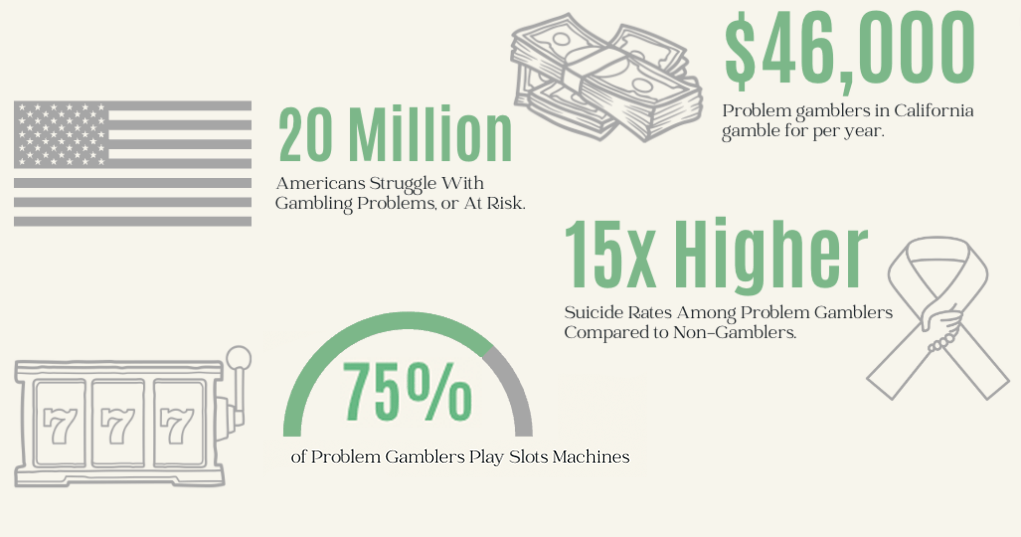
Key Gambling Addiction Stats
- Latvia has the biggest gambling problems in the World.
- Up to 20 million American have gambling problems or are at risk.
- Oklahoma has the highest rate of gambling addiction of all US states, with 6.2% of their population.
- The social cost for a gambling addict (PGSI 8+) is over $30,000/year.
- The prevalence of gambling addiction in men is 1.5-2x more common than among women.
- 50.2% of all slot machine players have gambling problems.
- In 2023, the US players gambled for $264B, or $1026/person over 18.
- Slot machines are the most addictive. 75% of problem gamblers play slots.
- 81% of gambling addicts play online.
- The average caller of the California gambling hotline spent $46000 annually on gambling.
- 3% of American problem gamblers have more than $300,000 in gambling debts.
- Suicide rates among problem gamblers are 15x higher than the general population.
- 60% of problem gamblers smoke, and 26% are alcoholics.
Gambling addiction statistics worldwide
Gambling is a global problem. The gambling addiction statistics worldwide varies between 1.2 – 6.0% . So, what country has the highest rate of gambling addiction? Which country has the most gambling addicts in the world? And what percent of the US population is addicted to gambling?
- Lativa has the biggest gambling problems in the world. 6.0% of the population in Latvia has problems with gambling.
- China has the most gambling addicts in the world. Close to 60 million Chinese are gambling addicts, or 4% of the Chinese population.
- In the United States, 1.2-6.2% are addicted to gambling. This means up to 20 million Americans have gambling problems or are at risk.
- In Australia, 3.1% have problems with gambling.
- 1.2 million Canadians, or 3.2% of the population, have gambling problems.
- A few other European countries: Austria 1.1, Denmark 3.2%, Finland 3.3%, France 2.9%, Germany 2.3%, Italy 3.0%, Norway 1.4%, Spain 2.2%, Sweden 4%, and the United Kingdom 2.8%.

___________
Sources: EGBA, ENG.IMS, GamblingResearch, Griffiths (2016), IHE, Malischnig (2018) Meyer (2021) Rotermann (2022), Valleur (2015), SFI, Syvertsen (2022)
Gambling Addiction Statistics United States 2025
Is gambling a problem in the US? Yes, it is. How many Americans have gambling problems? What is the prevalence of problem gambling among different ethnic groups? Which US state has the most gambling problems? How much do Americans gamble each year? Here is a list of problem gambling statistics the United States:
- How many Americans are addicted to gambling? Between 1.2-6.2% of Americans are problem gamblers. It means that as many as 20 million struggle with gambling.
- 50.2% of all slot machine players have gambling problems.
- 500,000 teenagers have gambling problems.
- 23% of homeless people have problems with gambling. There is a strong connection between problem gambling and homelessness.
- Approximately 4.8% of Asian Americans met the criteria for problem gambling.
- How much do Americans lose on gambling? In 2023, the US gamblers lost $264B, or $1026 per person over 18.. $264B was the total revenue of the American gambling industry in 2023.
- Which state has the most gambling problems? Nevada isn’t the most gambling-addicted state. Oklahoma has the highest rate of gambling addiction, with 6.2% of the population compared to 6.0% in Nevada.
- Gambling addiction rates US states: California 2.5%, Florida 1.2%, Illinois 3.9%, Michigan 3.2%, New York 4.3%, North Carolina 5.5%, Nevada 6.0, Ohio 1.4%, Oklahoma 6.2%

Problem Gambling Stats in ethnic groups
Some studies show differences in gambling addiction rates in different socioeconomic groups. That could explain the differences in problem gambling rates among racial and ethnic groups in the United States. Which ethnic group gambles the most? Which racial group has the highest rates of problem gambling? What are the rates of gambling addiction among different ethnicities?
- Among the Spanish-speaking population in Illinois, 7.3% had gambling problems in 2021.
- 4.8% of Asian Americans are reported to gamble problematically.
- 3.6% of African Americans struggle to control their gambling.
- 2.9% of the white American population in Illinois meets the criteria for problem gambling.

_______________
Sources: CDPH, ECU FCCG, IDSH1, Journal of Gambling Issues, KNPR, Nower (2015) NYCPG, OAPGG, ResearchGate, QG Survey 2024
Who is most affected by gambling addiction?
Are there more male gambling addicts than women? What age groups suffer most from gambling problems? Can kids have gambling problems? How common is gambling addiction among college students? What percentage of adolescents are at risk of developing a gambling problem?
Gambling addiction prevalence between genders & age groups
- Which gender is more prone to gambling addiction? Multiple studies show the prevalence of gambling addiction among men is 1.5-2x more common than among women.
- The age group with most gambling addicts is 18-24 at 7.1%
- Among 25-35-year-olds, over 5% have gambling problems.
- Between 35-54, 2.7% of the population are addicted to gambling.
- People older than 55 are least likely to be addicted to gambling at 0.5%
- Prevalence of gambling problems in kids: 4-5% of kids ages 12-17 show one or more signs of problem gambling. One study showed that 10-14% of high school kids are in the risk zone of developing gambling problems. Boys gambled more than girls.
- Approximately 500,000 American adolescents have gambling problems.
- 75% of college students have gambled in the last 12 months.
- 6% of college students gamble compulsively, and another 8% are at risk of developing a problem.
- Problem Gambling is more common among people living alone.
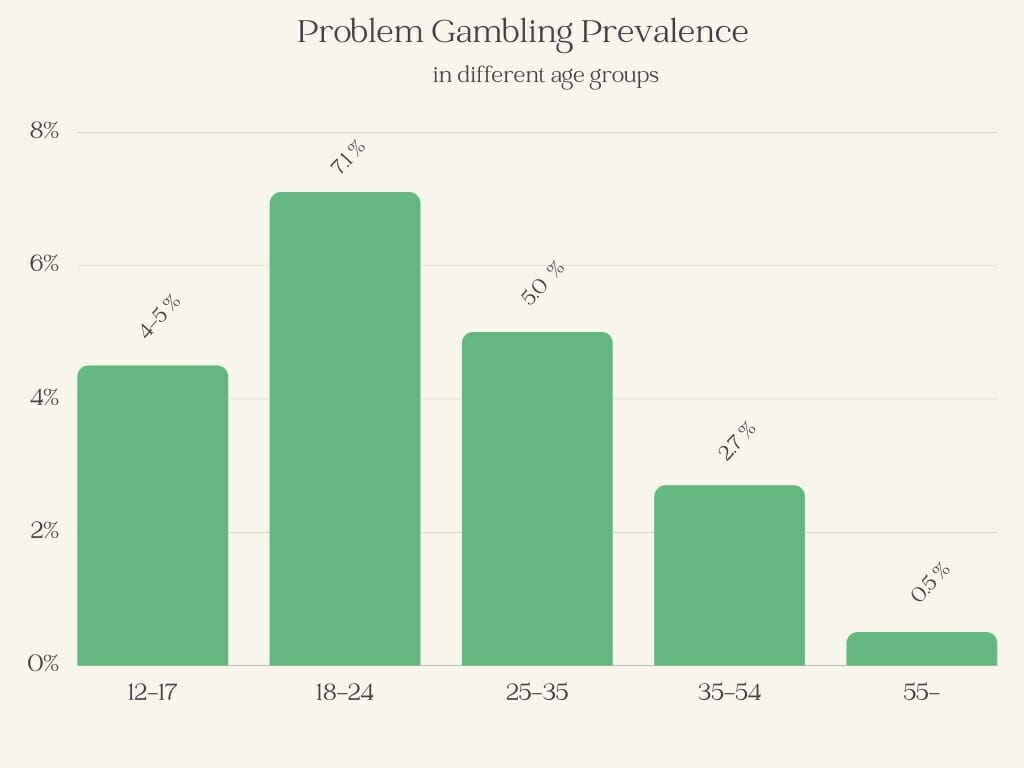
Suicide Statistics for gambling addicts
Gambling addiction is the addiction with the highest suicide rates among all addictions. It’s one of many tragic facts about gambling addiction. So, what is the prevalence of suicide among problem gamblers? How common is suicide among gambling addicts? How many gambling addicts commit suicide compared to the general population? How big part of all suicides can be connected to gambling problems?
- Suicide rates among problem gamblers are 15x higher than the general population (ages 20-74)
- 30% of problem gamblers in the UK said they had tried to commit suicide before entering gambling treatment.
- In the UK, 4-11% of all suicides are gambling-related.
- Mortality rates in ages 20-74 are 1.8x higher than the general population.
- In the age group 20-49, the mortality rate for problem gamblers is 6.2x higher, and the suicide rates are 19.3x higher than the general population.
_______________
Source: Appleby (2017), BeGambleAware, GWL, IDSH1, IHE, LU, TeenHelp, Wong (2010), Wong (2016),
Gambling Behaviour among Gambling Addicts
What casino games are most addictive? What do problem gamblers gamble on? How are sports gambling addiction statistics 2025 compared to casino gambling statistics? Are there any gambling statistics on how addictive slot machines really are? Are online gamblers more likely to develop an addiction compared to offline gamblers? The following problem gambling statistics come from a survey conducted among 3200 gambling addicts on QuitGamble.com in 2024. So, what types of gambling are most associated with addiction?
What games cause most gambling problems?
- 76% of American problem gamblers play slot machines. Globally, that number is slightly lower at 75%.
- 24% bet on sports in the US, a number that is likely to increase in 2026
- . Worldwide, 38% of gambling addicts do sports betting.
- Worldwide, 39% of problem gamblers play live casino games, 18% on lotteries, and 13% bingo.
- 50.2% of all slot machine players have gambling problems.

Online Gambling Addiction Statistics 2025 among problem gamblers
Online gambling is still relatively small in the US compared to other countries. The online gambling addiction statistics are likely to be smaller in the US than worldwide.
- Worldwide, 81% gamble online. In the US, only 59% of problem gamblers gamble online.
- Worldwide 33% of problem gamblers gamble on land-based gambling venues. In the United States, that number is 57%!
- About 20% of the US licensed gambling revenue comes from online gambling.
___________
Source: AGA, QG Survey 2024,
Statistics for Financial Consequences of Gambling
Gambling can have devastating financial consequences. What do gambling addiction facts say about: How much do gamblers lose? How much does gambling cost the society? What is the economic impact of gambling addiction on society? What percentage of homeless individuals have a gambling addiction? How much debt do gambling addicts have? What is the average amount of debt accumulated by gambling addicts? Which country loses the most money to gambling?
How much do gambling addicts lose in a year?
- One study showed that problem gamblers estimated losing a median of $16,750 per year.
- Which countries lose the most money in gambling? Australians spend the most money gambling in the world, over $1000/gambler per year.
- In California, the average gambler calling the gambling hotline spent $46,000 per year on gambling in 2020.
- At-risk gamblers lose around $3,000 annually, while recreational gamblers lose about $500 annually.
- In the United States, Americans spent $264B on gambling in 2023, or $788/capita or $1026 per person over 18 years old.
- Only 50% of the money gambled in casinos comes from funds that patrons carry with them. The remainder is lent money. The casinos levy an interest rate of 3% to 10% or higher for this service.
- A study of nearly 300 homeless individuals showed that 23% had problems with gambling. There is a strong connection between problem gambling and homelessness.
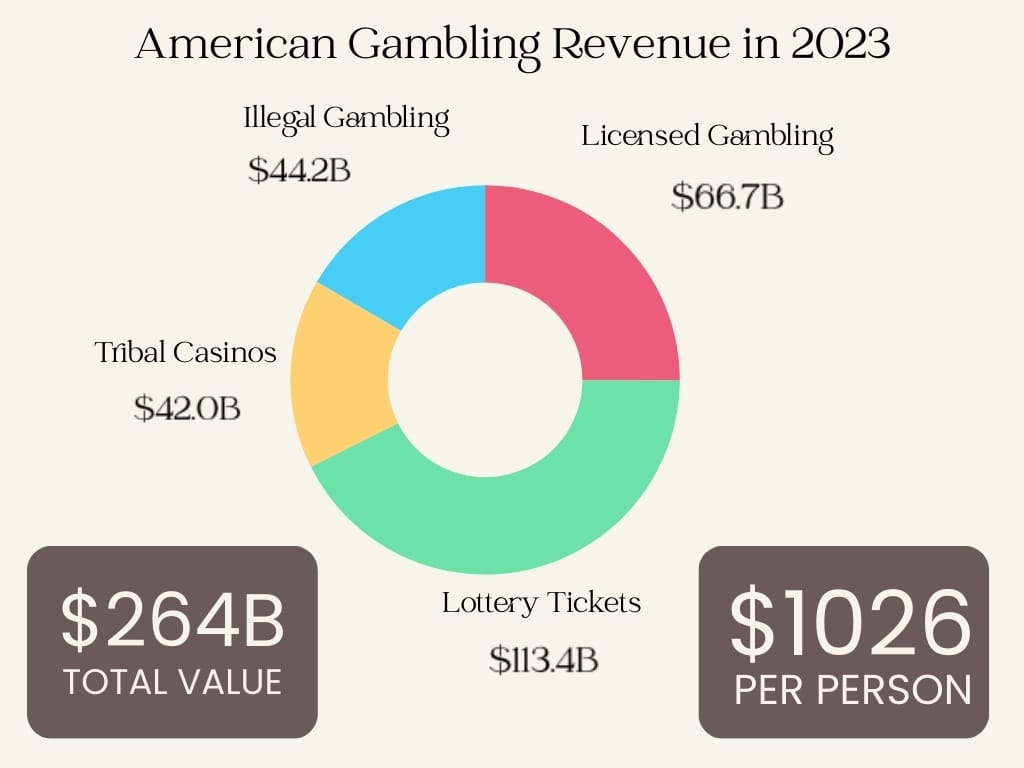
Gambling debt Statistics:
Gambling debt includes credit cards, loans, and borrowing from friends/family. What is the average gambling debt for a person with a gambling addiction? What is the average amount of debt accumulated by gambling addicts?
- How many people go into debt from gambling? Globally 73% of problem gamblers have gambling debt. In the US, 81% of gambling addicts struggle with gambling debt.
- Our survey showed that it is more common among women to struggle with debt: 78% of female gambling addicts compared to 71% of males.
- Among American problem gamblers, 33% have gambling debts between $10,000-$50,000, and another 21% have gambling debt in the $50,000-$100,000 range.
- 3% of American problem gamblers have more than $300,000 in gambling debts.
- Female problems gamblers have, on average, $15,000 of gambling debt.
- 20% of problem gamblers file for bankruptcy because of all the money they’ve lost to gambling.
How much does gambling cost the society?
What are the healthcare costs associated with gambling addiction? How much do employers lose due to employees with gambling addiction? What are the social costs of problem gambling?
- According to a Swedish study, a person with severe gambling problems (PGSI 8 or higher) costs $30,000/year. The cost includes healthcare, treatment, productivity loss, unemployment, crime, homelessness, and suicide.
- For a problem gambler at PGSI 3+, the cost is around $14,000.
- The average problem gambling (no matter the severity) costs the Swedish society $4,400/year.
- In Sweden, the cost of problem gambling was over $1.4B (14B SEK) in 2019.
- Studies in Australia show similar costs/problem gamblers as Sweden. In 2015 the estimated cost of problem gambling in Australia was $3.5B (AUD 4.7B)
- Problem gambling costs the US society $8B/year.
- If the same cost/problem gambler as Sweden or Australia is applied to the United States, the cost of problem gambling can be as high as $88B/year!
- In the UK, the cost of problem gambling exceeds $2.2B/year (£1,8B)
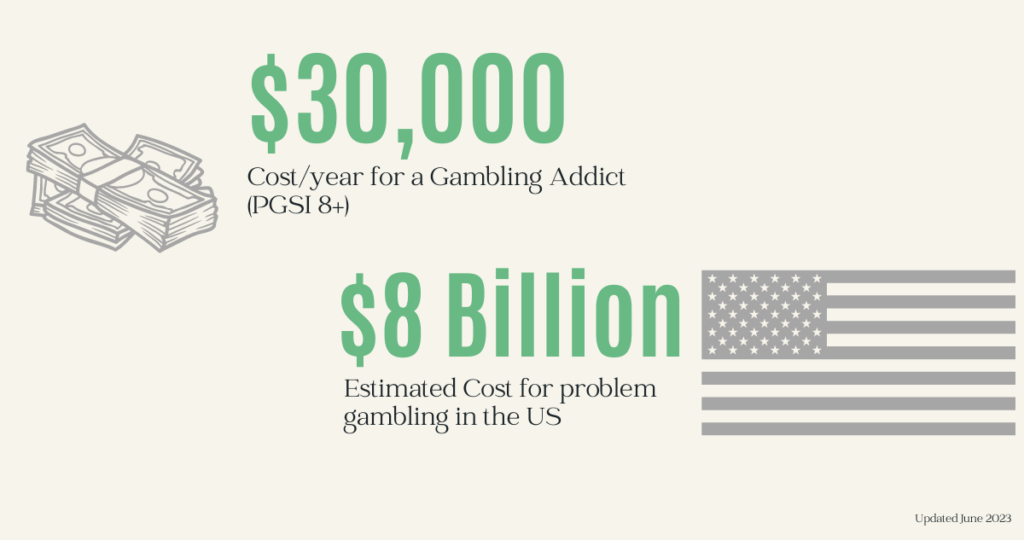
Gambling Addiction & Crime Activity Rates
Problem gambling and crime have significant societal and personal costs. Research shows that problem gambling is strongly associated with criminal activity. What percentage of gambling addicts commit crimes to support their addiction? How much do compulsive gamblers steal? Are pathological gamblers more criminal than problem gamblers?
- 50% of problem gamblers have committed crimes.
- 63% of GA members had written bad checks, and over 30% had stolen from their workplace.
- 67% of gambling addicts committing crimes said in a study that they only did it to support their gambling directly.
- In a study with 400 Gamblers Anonymous members, over 57% said they had stolen money to finance their gambling. The average individual has stolen $135,000.
- 73% of prison inmates showed signs of gambling problems.
- One-third of prison inmates have a history of problem gambling.
- Among offenders identified as severe problem gamblers, 68.8% admitted to theft or unlawful procurement of funds to settle gambling-related costs or debts, in contrast to only 26.3% of those deemed moderate problem gamblers.
- Pathological gamblers are imprisoned at nearly twice the rate of problem gamblers and nearly 6x more often than low-risk gamblers.
- Just 5.4% of prisoners with gambling problems reported receiving treatment or attending self-help meetings.
Money in Gambling Addiction Statistics
How much money do gambling addicts contribute to the gambling industry? What percentage of gambling revenues come from problem gamblers? What do sports gambling addiction statistics say about part of revenue coming from problem gamblers?
- In sports betting, 86% of the revenue comes from 5% of the players.
- In live casinos and slots, the losses of 5% of the players amounted to 74% and 70% of the casino revenue.
- 5% of virtual casino accounts with the highest annual stakes accounted for 82% of the revenue.
- Slots and casino games accounted for 93% of all revenue for gambling companies.
_________
Source: AGA, BBC, Blaszczynski, debt.org, GGS2, GOV, GREO, LWW, NatCen, ICTNews, IDSH1, IHE, Lesieur (1998), LSE, NIGC, Research, QG Survey 2024, Schwer (2003), SGD, Statista 1, Statista 2, Walters (2005), William (2005),
How common are Gambling Addiction and Co-Occurring Disorders?
How many gambling addicts have a history of mental health issues? A staggering 96% of problem gamblers also meet the criteria for another mental illness. Is there a connection between ADHD and compulsive gambling? What is the relationship between gambling addiction and substance abuse?
- 60% of problem gamblers smoke, according to 11 studies across multiple countries.
- When banning smoking in gambling venues in Australia, Canada, the US, and Europe, gambling revenue dropped by 15-25%.
- 28% of problem gamblers have alcohol problems, and 60% have had problems with alcohol in their life.
- 17.2% have substance abuse disorder.
- One study showed that 29% of compulsive gamblers had childhood ADHD compared to 6-9% among non-gamblers)
- 69% have experienced serious anxiety or symptoms of depression in the past year. (Compared to 10.8% among non-gamblers)
- Other common addictive behaviors among people with gambling disorder are Pornography 29%, Video Gaming 26.7%, Work 39.6%, and Food 32.0%.
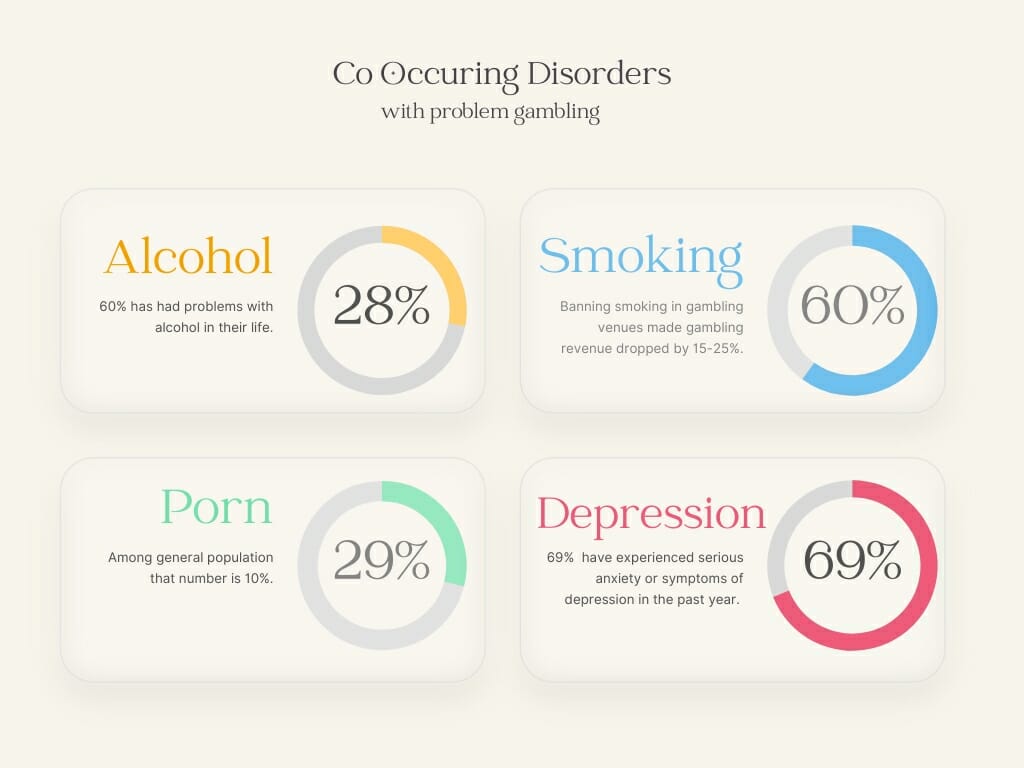
_________
Source:
N. Aymamí (2015), IDSH1, Rodriguez-Jimenez (2006) Thought Hub, UNLV, Alberta Gambling Research Institute, Lorains (2011)
Treatment of Gambling Addiction and Success Rates
Among gambling addiction statistics worldwide, what percentage of gambling addicts seek treatment? What is the success rate of treatment for gambling addiction?
- As Swedish study showed that 75% of people seeking help for problem gambling were men.
- On QuitGamble.com, 67% of the members are men worldwide.
- Among the American users, 50% of the members on QuitGamble.com are women.
- Less than 12% of pathological gamblers have sought treatment.
- Over 90% of problem gamblers relapse.
- 44.6% said they were too embarrassed to ask for help
- 25% didn’t seek help because they didn’t think they would stop gambling anyway.
- A study indicated that 39% of people with gambling problems recover without treatment. These gamblers are called naturally recovered.
- One study in Illinois showed that 64% of people with gambling problems tried to gamble less, but two-thirds failed to do so.
- Among people with problem gambling, 38.0% have received services in the past year for alcohol misuse, 36.3% for drug misuse, and 36.8% for stress or depression.
- Less than 10% of 232 consecutive attendees of Gamblers Anonymous meetings became actively engaged in this fellowship and managed to stop gambling a year later.
________
Sources: Brown (1988), DSG (2022), FHM (2024), Hodgins (1999), IDSH1, QG Survey 2024, Slutske (2006)
Gambling Addiction Statistics Sources
AGA: American Gaming Association
Appleby (2017): Suicide by children and young people. National Confidential Inquiry into Suicide and Homicide by People with Mental Illness (NCISH). Manchester: University of Manchester
Blaszczynski (1989) – Blaszczynski, A., McConaghy, N., & Frankova, A. (1989). Crime, antisocial personality, and pathological gambling. Journal of Gambling Behavior, 5(2), 137-152.
DHS (2022) – Wisconsin Department of Health Services Relapse – Substance Use v Gambling
GGS. Gambling in the Golden State 1998 Forward, By Charlene Wear Simmons, Ph.D. Assistant Director
Hodgins, D. C., Wynne, H., & Makarchuk, K. (1999). Pathways to recovery from gambling problems:
Follow-up from a general population survey. Journal of Gambling Studies, 15, 93–104.
IDSH: 2021 Statewide Assessment of Gambling and Problem Gambling in Illinois
Rodriguez-Jimenez (2006) – Impulsivity and sustained attention in pathological gamblers: Influence of childhood ADHD history. Journal of Gambling Studies, 22, 451–461
Lorains (2011) Prevalence of comorbid disorders in problem and pathological gambling: a systematic review and meta-analysis of population surveys
Lesieur (1998) – Henry Lesieur: Testimony Before the National Gambling Impact Study Commission, Atlantic City, New Jersey (January 22, 1998) (Institute for Problem Gambling).
LSE Research: Measuring gambling-related harms: a framework for action 2018 Heather Wardle, Gerda Reith, David Best, David McDaid and Stephen Platt
Malischnig (2018) – A brief overview of the Austrian gambling regulation and implication for player protection and harm minimization.
N. Aymamí (2015) – Clinical, Psychopathological, and Personality Characteristics Associated with ADHD among Individuals Seeking Treatment for Gambling Disorder
NIGC: National Indian Gaming Commission
Nower (2015) – Nower L, Eyrich-Garg KM, Pollio DE, North CS. Problem gambling and homelessness: results from an epidemiologic study. J Gambl Stud. 2015 Jun;31(2):533-45. doi: 10.1007/s10899-013-9435-0. PMID: 24395010.
Schwer (2003) – Schwer, R. K., Thompson, W. N., & Nakamuro, D. (2003, February). Beyond the limits of recreation: Social costs of gambling in southern Nevada. Paper presented at the Annual Meeting of the Far West and American Popular Culture Association, Las Vegas, Nevada.
Slutske (2016) – Slutske W. S. Natural recovery and treatment-seeking in pathological gambling: results of two US national surveys. Am J Psychiatry 2006; 163: 297–302.
Stewart (1988) – Stewart, R. M., & Brown, R. I. F. (1988). An outcome study of Gamblers Anonymous. British Journal of Psychiatry, 152, 284 – 288
Walters (2005) – Walters Glenn, The Effect of a Gambling Lifestyle Group Intervention on Subsequent Disciplinary Adjustment in Male Prisoners Addictive Disorders & Their Treatment 4(1):p 21-28, March 2005.
Williams (2005) – Williams, R.J., Royston, J., & Hagen, B. (2005). Gambling and problem gambling within forensic populations: A review of the literature. Criminal Justice & Behavior: An International Journal 32(6), 665-689.
Wong (2010) – Wong, P.W.C. et al. (2010) A psychological autopsy study of pathological gamblers who died by suicide. Journal of Affective Disorders 120, 213-216
Wanna know more?
Read about gambling addiction statistics in other languages.
 English
English Español
Español Français
Français Português
Português Svenska
Svenska
